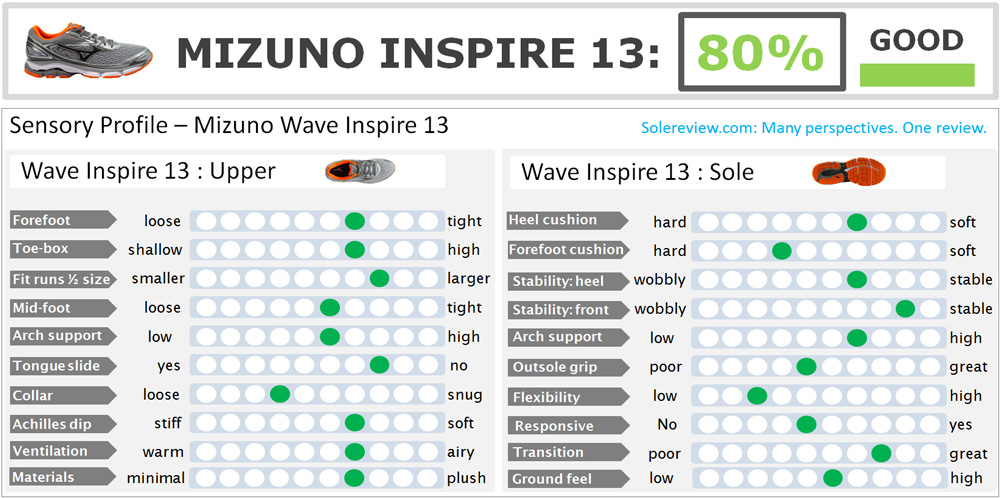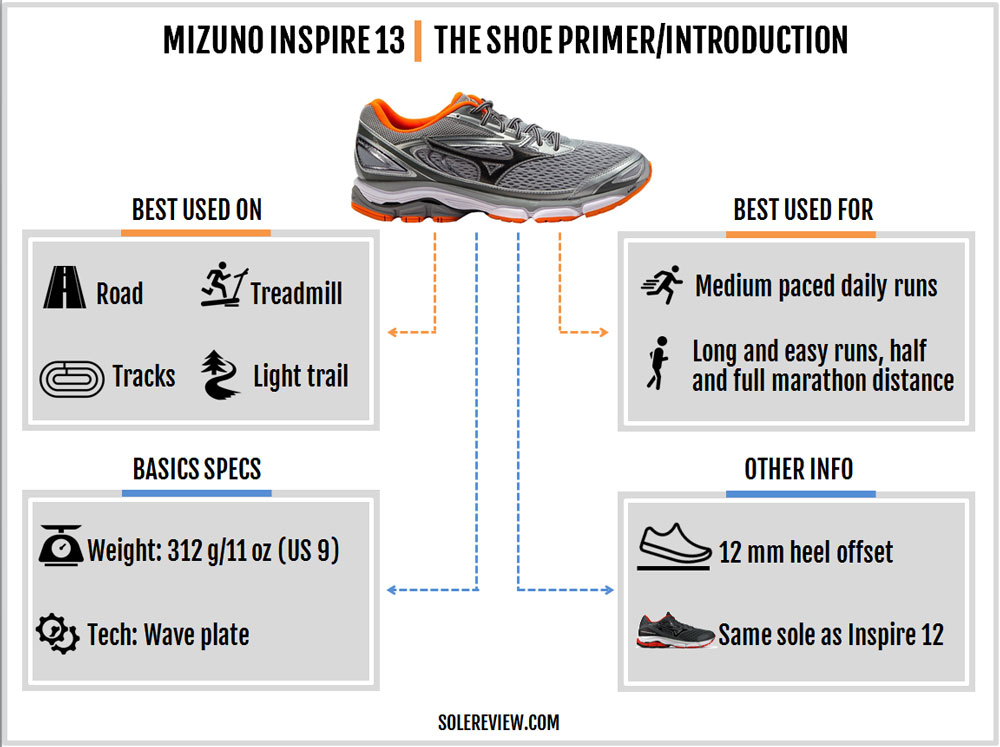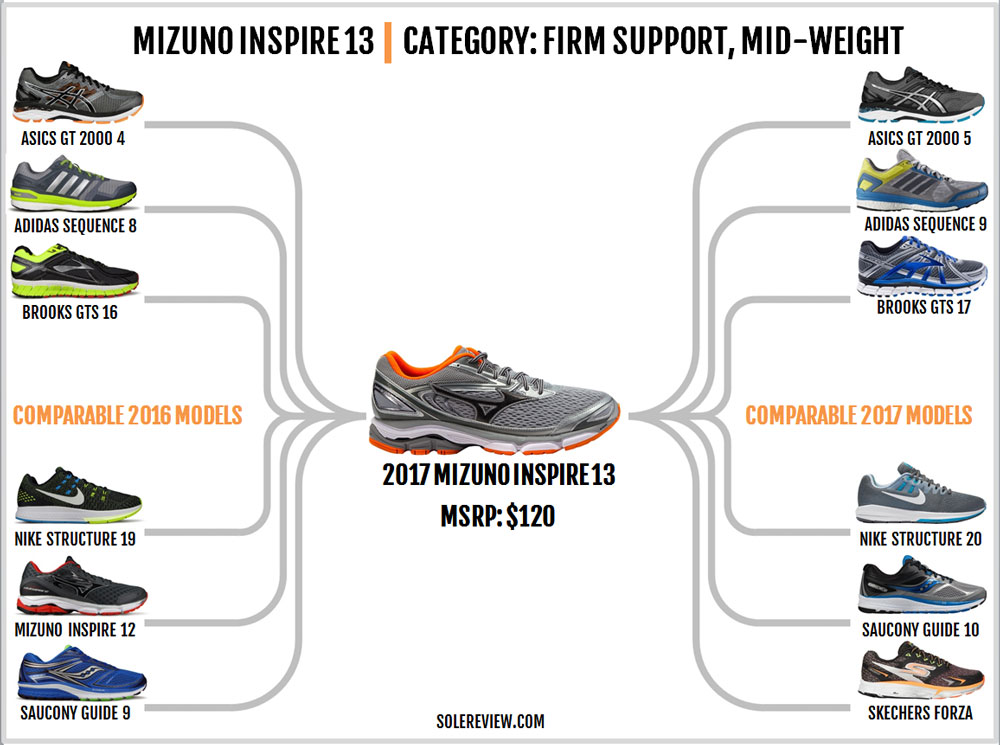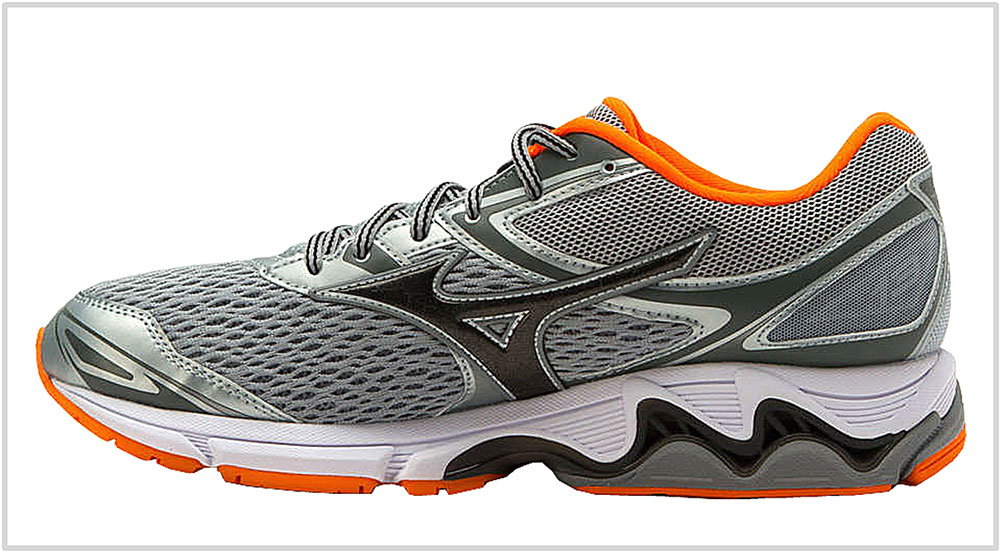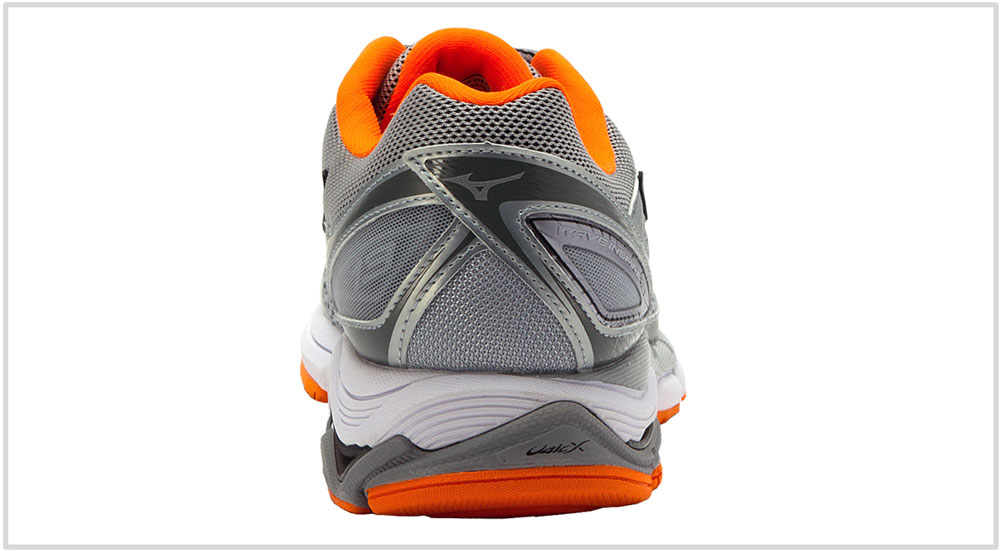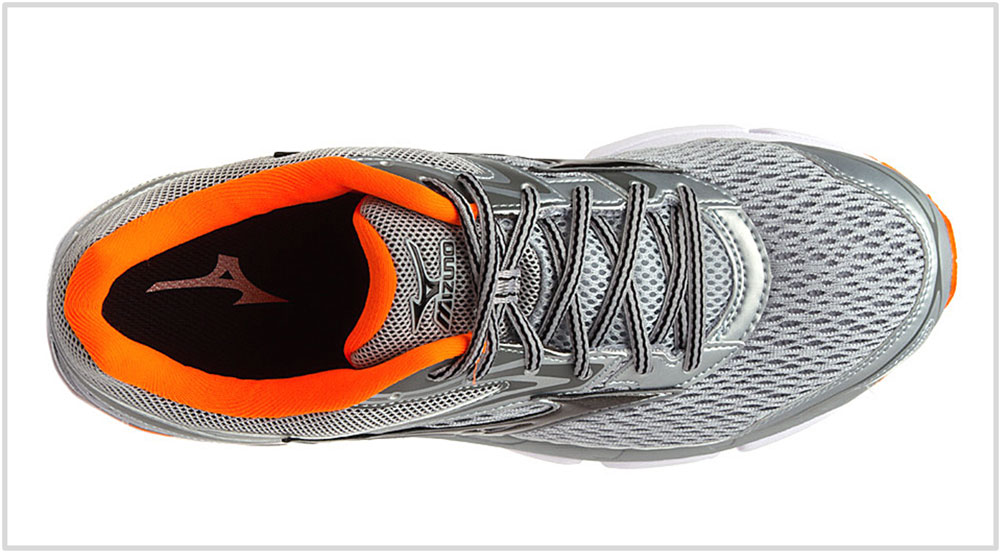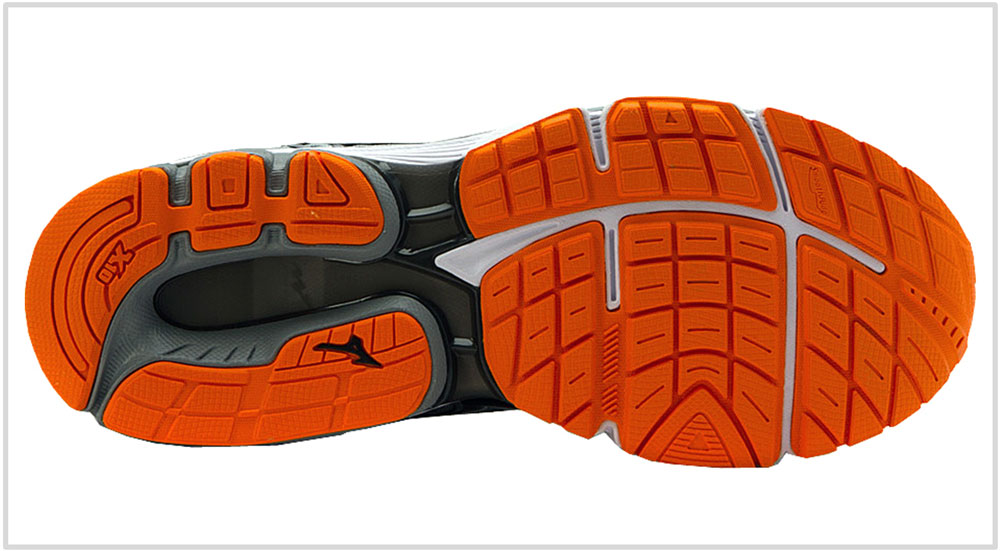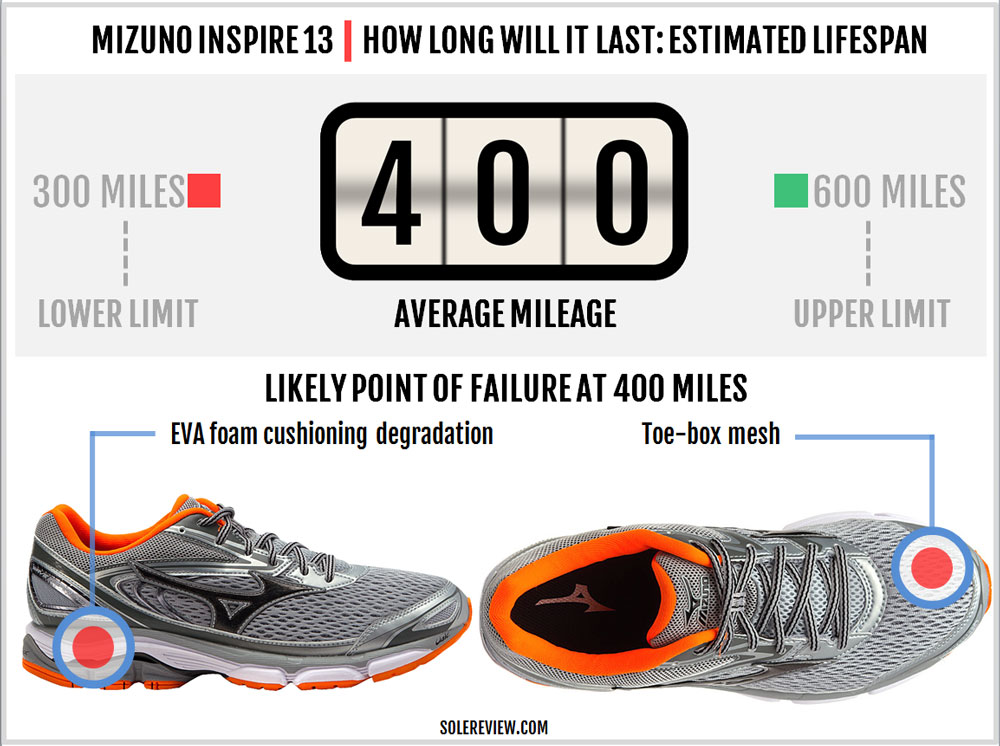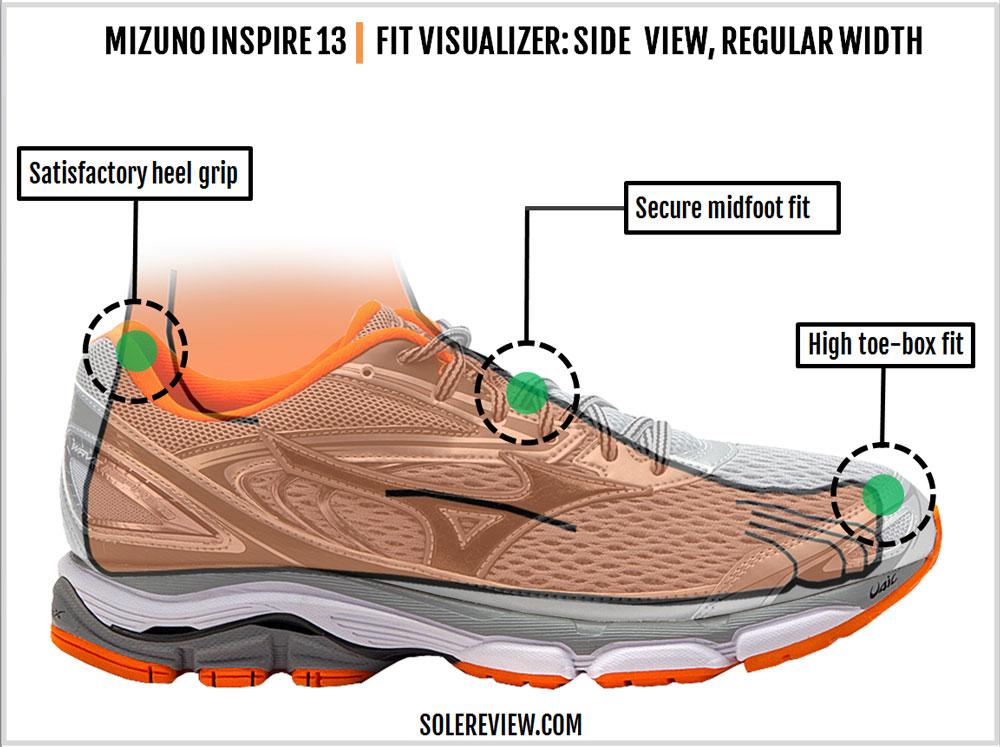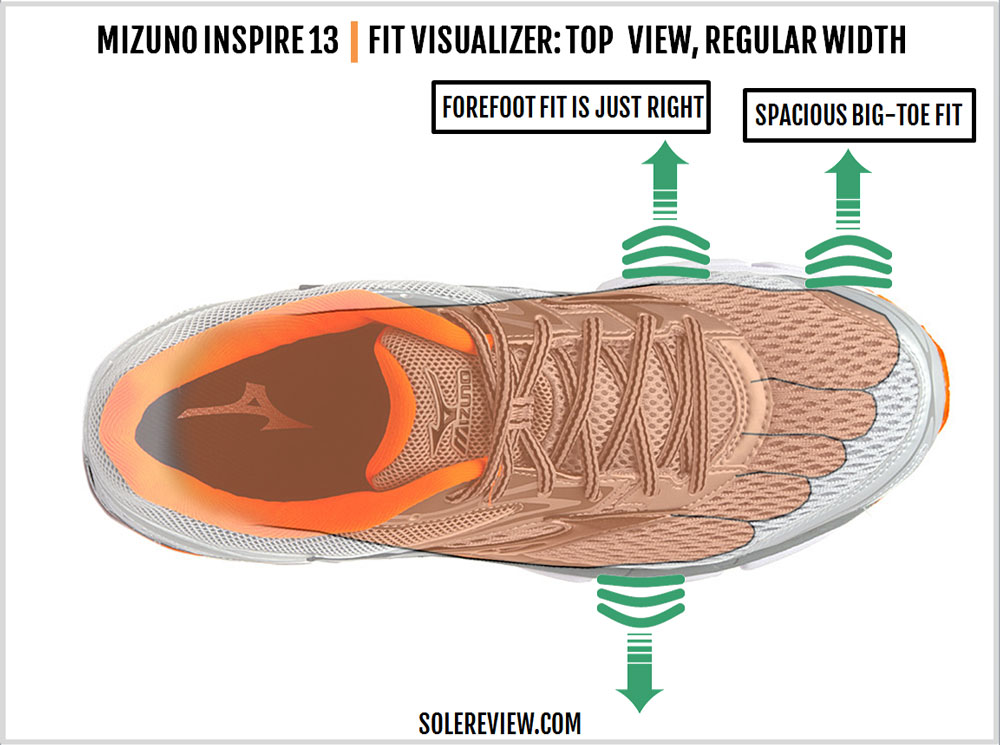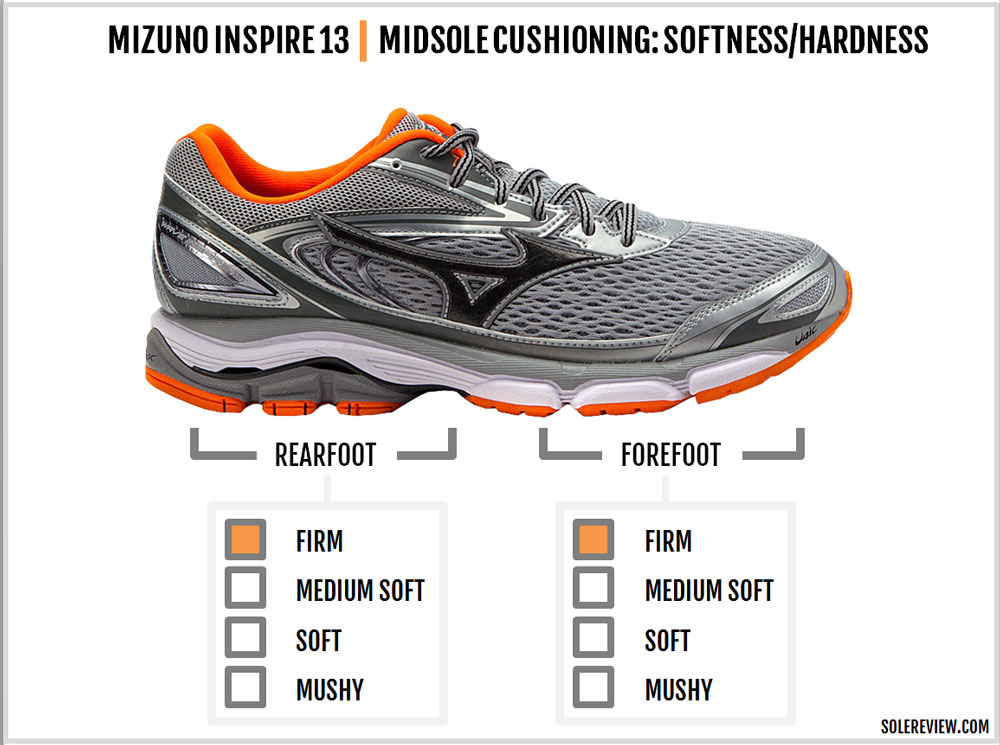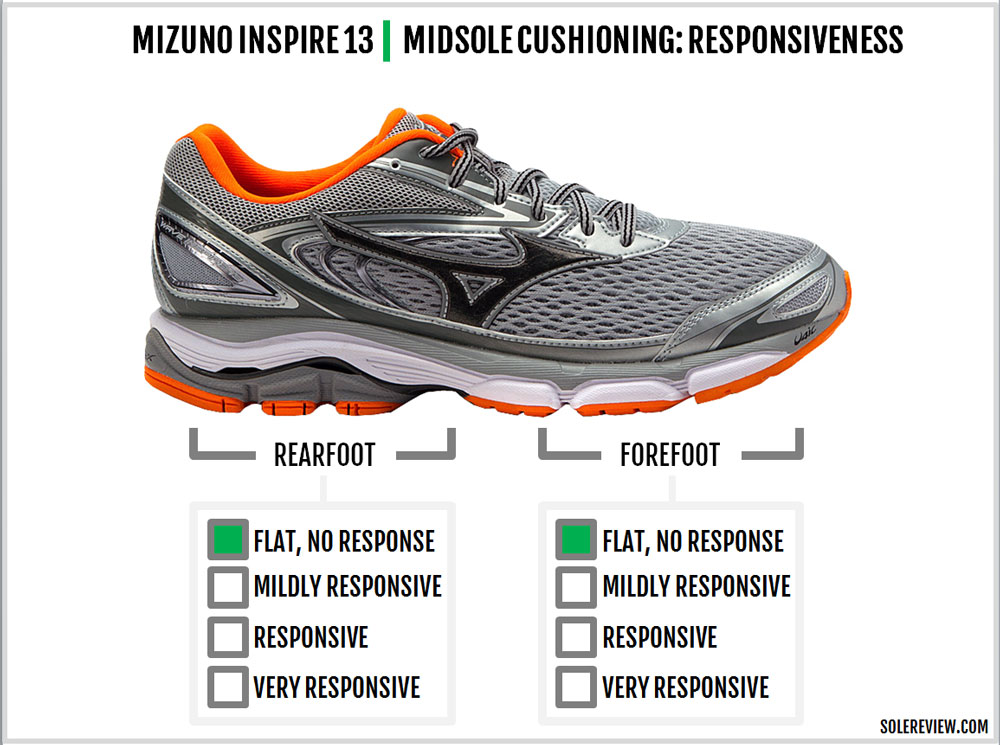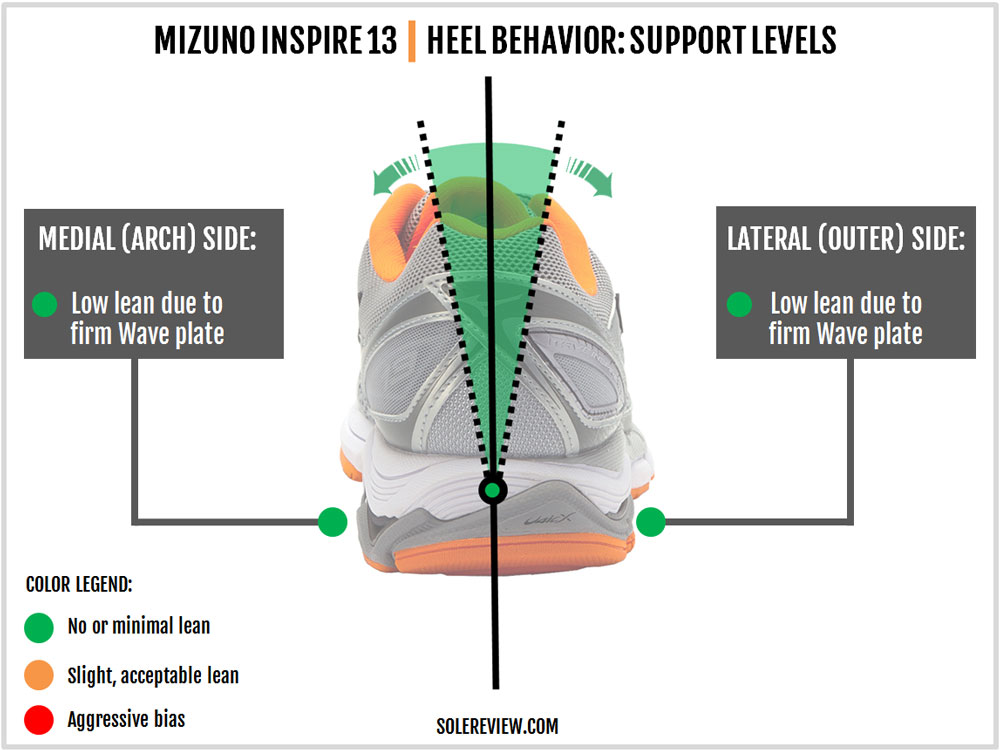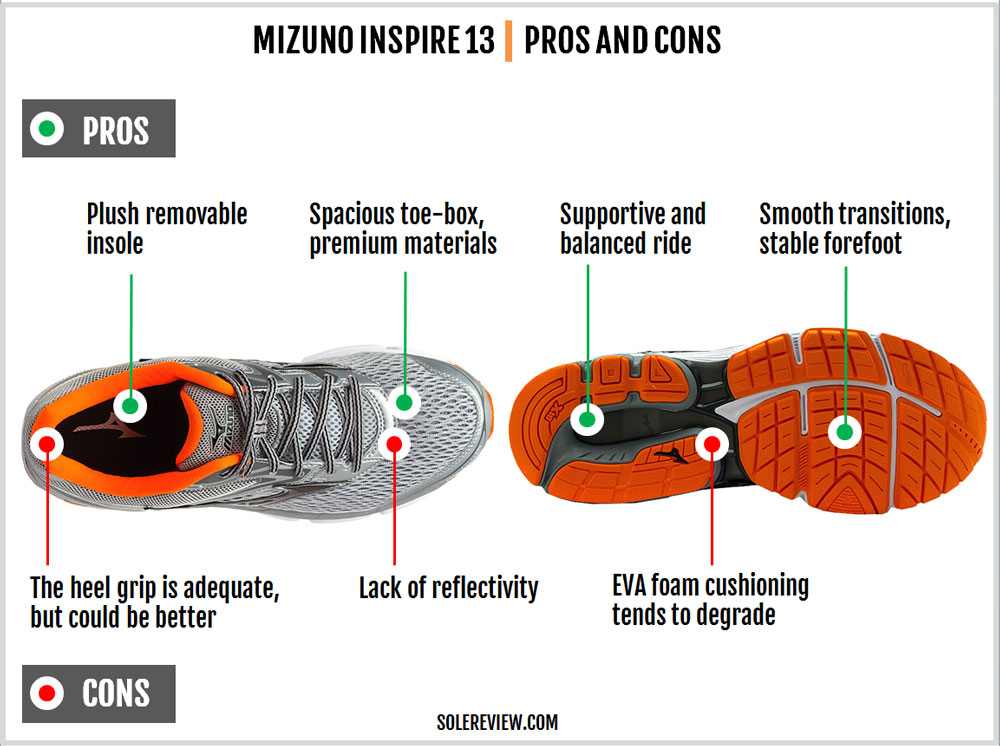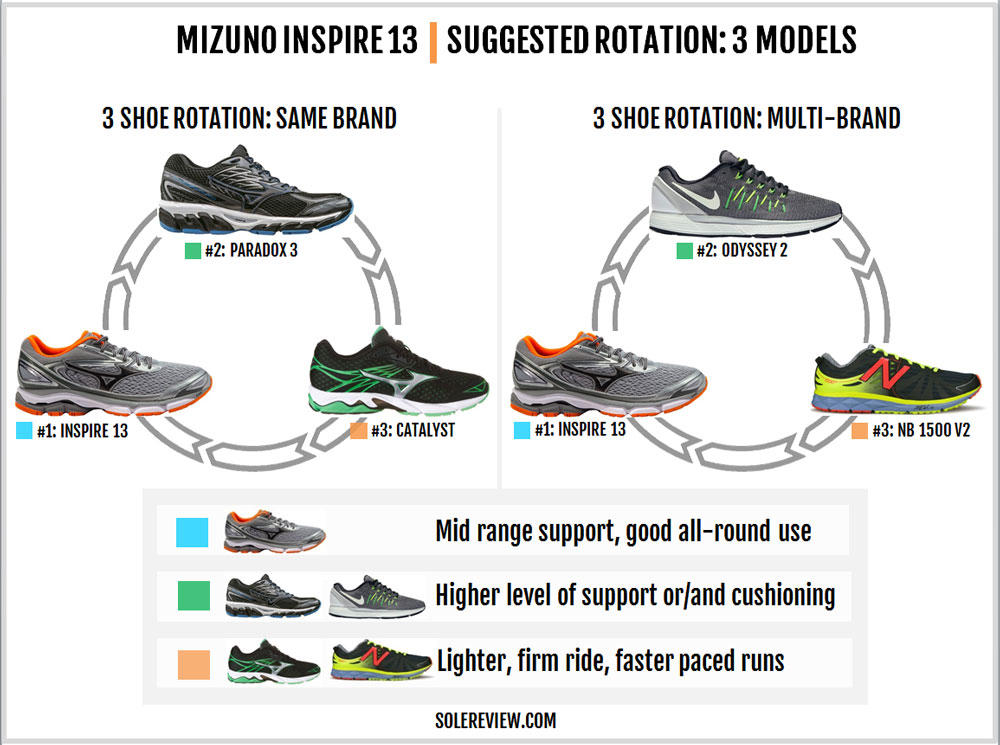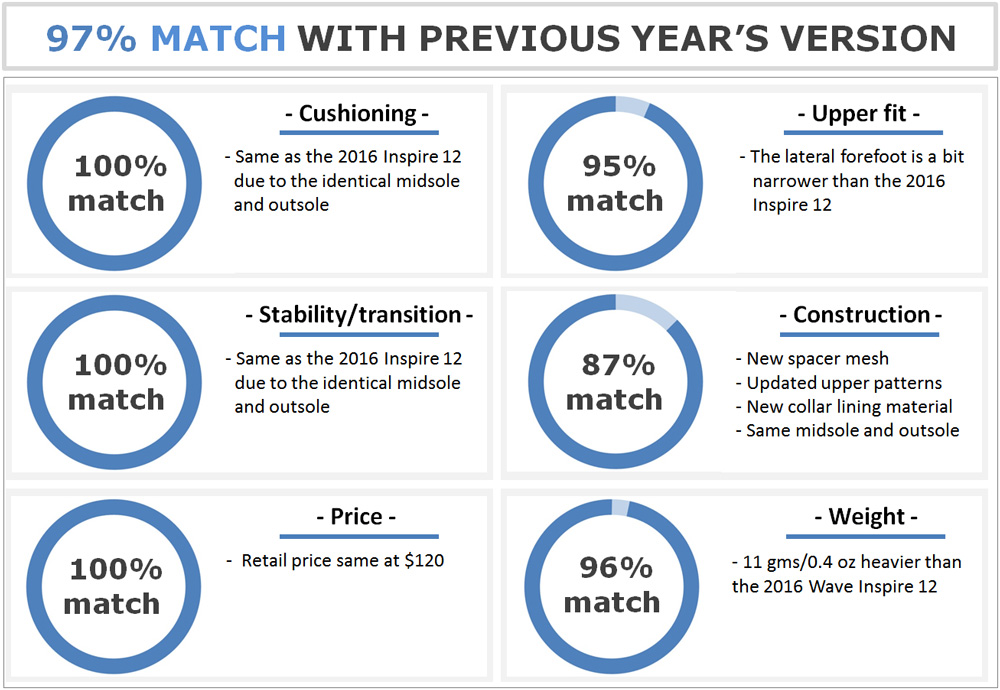INTRODUCTION
The annual Mizuno update ritual is the epitome of incremental footwear evolution.
You can rest assured that a Mizuno is always going to ride like a Mizuno, courtesy the Wave plate plugged into the midsole. The upper doesn’t seem to change a lot either; the Mizuno Inspire 11, 12 and 13 are great examples of how Mizuno approaches the update process.
There have been small tweaks made to the upper design template, but that hasn’t swung the needle on the actual fit quality. As with all annual refreshes, minor redecoration is expected, but nothing which alters the core ride or fit character of the shoe.
The 2017 Mizuno Wave Inspire 13 also happens to be the result of mild updates made to the Inspire 12. For starters, the combined sole unit – which comprises of the insole, midsole, and the outsole – is carried over from the 12 without changes.
While the 13’s upper has been redesigned, the fit stays more or less the same. So – if you’re currently running in a pair of the Inspire 12, then upgrade to the 13 without fear. That, or save money by stocking up on a few pairs of the Inspire 12.
A chart like this is irrelevant when it comes to Mizuno shoes, but still, you should know which other beasts roam in the wild. Mizuno’s Wave plate equipped midsoles produce a ride which is unlike any other non-Mizuno shoe. The other thing you should know is that Mizuno treats its ‘stability’ shoes differently.
For instance, the Inspire 13 is Mizuno’s mid-priced stability/support shoe, but it doesn’t behave very differently than a Rider 20, which is the neutral version of the Inspire. That’s because Mizuno does not rely on a conventional medial post, and instead uses a variation of its Wave plate to separate the two categories.
The word ‘separation’ is used in a relative sense. Both the Rider 20 and Inspire 13 can be used interchangeably, for there isn’t a lot of difference between the two. When it comes to a Mizuno, the functional chasm between a neutral and stability shoe is very narrow and can be easily hopped over.
But for whatever it’s worth, this chart sums up the support category as defined by brands. The following overview should help if you’re not a current Mizuno user and want a better understanding of what you’re buying.
Within this assortment, the Asics GT-2000 5 and the Skechers GoRun Forza have the softest ride, with Asics adopting the traditional medial-post approach. The GoRun Forza has a completely different design, but that’s a story for another day.
The Nike Structure 20 and the Saucony Guide 10 are firm and balanced support shoes, and both make use of a medial post. The Structure has a responsive forefoot because of the Zoom Air Bag, while the Everun topsole fitted Guide 10 delivers a mildly responsive ride. The Brooks Adrenaline GTS 17 is a well-rounded, traditional support shoe without any superpowers.
Like the Inspire 13, the adidas Sequence 9 is an outlier in the sense that it delivers a non-traditional support design in a responsive ride package.
DESIGN AND MATERIALS
The Inspire 13’s upper depends on a lot of stitched-over components and partial molding, which is similar to the how the Inspire 12 was put together. The upper layout looks familiar; the front has a synthetic leather bumper with newly added cosmetic detail.
Not a lot has changed around the midfoot. Both sides sport the Mizuno ‘Runbird’ logo in all its molded glory, and the split-lacing eyestay is very similar to the previous models. The Inspire 12 introduced soft semi-stretch laces (the 11 had hard, scratchy ones), and the 13 carries that over.
The midfoot has cosmetic TPU molding similar to the 12, and the heel features a combination of synthetic leather and metallic-colored molding which highlights the branding. Though the materials have been rearranged a bit, it has no functional effect.
There are material updates to the heel lining and the entire outer upper mesh. The heel uses a similar, but softer fabric lining with the same levels of foam fill inside. The mesh is a new spacer type; it is interesting to note that the Inspire 13 uses a regular kind of mesh while the Rider 20 has moved on to an engineered mesh.
The new upper mesh feels more spongy than last year, and it comes with an update which isn’t visible from the outside. If you run your fingers under the forefoot, you’ll sense two backing strips reinforcing the mesh from beneath. These strips connect the either ends of the toe-bumper to the first lacing row.
If you remember, the Inspire 12 did not have this. It had a backing material, but right under the center and not the sides. The Inspire 13 is based on the Inspire 11 internal design which used these strips underneath. That sameness aside, there’s a slight difference in execution as the 13’s strips are a thinner kind.
The tongue has no sleeve. Mizuno’s way of fixing tongue slide has been to make the tongue flap extremely wide, and that has proven to minimize sideways movement. It has worked on past Mizuno models, and it does on the Inspire 13 too.
Do any of the design updates end up making a functional difference versus the 12? Only the synthetic leather strip on the outer forefoot does, and we’ll revisit this topic in a bit.
There’s no change made to the sole when compared to the Inspire 12. Right at the top, a removable insole made of open-celled foam (topped with a smooth fabric) makes for a plush underfoot experience.
The Inspire 12 changed the lasting material below the insole from fabric to foam, and that remains exactly the same on the latest Inspire.
Most Mizuno models use a triple-density midsole regardless of the category. A Mizuno midsole usually consists of a primary midsole foam layer, the Wave plate, and finally the foam under the heel. In the Inspire 13’s case, it is Mizuno’s firm U4ic EVA foam on top, a heel-to-midfoot Wave plate, and the softer U4icX crash pad just above the outsole.
The outsole is identical to the outgoing model’s, and it is split into a softer blown rubber forefoot and a harder X-10 carbon rubber compound under the heel. The heel section has a deep cavity, and the outsole is mounted on the U4icX foam pillars.
If you compare the Wave Rider 20 and Inspire 13 side-by-side, the Wave plate design looks similar. Well, it is nearly identical on the lateral (outer) side. It is only when you turn the shoe around that you realize that the Inspire’s Wave plate has a different design.
The ‘troughs’ and ‘crests’ on the Inspire’s medial Wave plate is more aggressive than the Rider 20’s. The Rider 20 has a single ‘crest’ on its medial wave, whereas the Inspire 13 has a double crest which is also molded thicker than the Rider 20. And this is how Mizuno separates the Inspire and Rider from a category standpoint.
What they say of Mizuno’s break-in period is true. Considering the multiple layers of materials, the midsole needs around 50 miles for all the components to bed in properly. This trait is unique to Mizunos; most non-Mizuno shoes feel nearly the same at mile 50 as it does at mile 5.
A Mizuno typically comes with a reasonable lifespan, which in empirical terms translates into a median of 400 miles. The outsole lasts beyond the industry average, helped by both the hard rearfoot rubber and overall flat geometry of the forefoot lugs.
As with most Mizunos, there are a couple of things you should know. Historically, the forefoot mesh and the midsole EVA have been the Inspire’s weak links in the chain. There have been reports of the forefoot mesh tearing due to friction with the toes. Mizuno has attempted to address this with the internal strips/fabric we talked about, but still.
The second durability area isn’t what shows up as actual wear, but as a gradual loss of cushioning properties. As you know, Mizuno uses regular EVA foam for its midsoles. When combined with the bedding-in process of the Wave plate composite, the ride seems to go flat after a couple of hundred miles.
Just know that it isn’t all about the midsole foam. The blown foam insole will eventually lose its cushioning properties over time, and it is often hard to distinguish the loss in insole cushioning from that of the midsole foam.
UPPER FIT AND FEEL
The Inspire 12 had a very spacious toe-box area, and that doesn’t change on the 13. The stitched-over synthetic bumper results in ample vertical room. If you skipped the 12 and are coming straight from the Inspire 11, then know that the 13 has a taller toe-box.
Thick Mizuno logos over the midfoot sides makes it necessary for internal seams to exist. These seam tapes cover the stitch line; while these don’t irritate during runs, they do create a localized, band-like midfoot pressure. This is one of those Mizuno idiosyncrasies you learn to live with.
The heel lining is softer, and the grip is same as before. Neither the Inspire or Wave Rider have been known for a plush heel fit, so don’t expect anything new here. The heel collar does a decent job of gripping the ankles without slippage, which is good enough.
The same toe-bumper which creates vertical room also makes the toe-box wide. No toe-crunching business on the Inspire, as there’s enough room to splay. The forefoot fit is just right, neither too roomy nor too narrow.
It is worth pointing out to Inspire 12 owners that the Inspire 13 feels slightly snugger on the lateral/outer side. This is because the 13 gets a new strip of synthetic on the lateral side, hemming in the small toe a bit. You’ll feel this only when comparing the 13 to the 12; as a standalone shoe, the forefoot has no fit concerns.
The Mizuno Inspire 13 sizing fits true-to-size.
RIDE QUALITY AND BEHAVIOR
At slower running speeds, you’ll sense the soft insole working underfoot. After all, it is a chunky sheet of foam above another foam layer of lasting, so the Inspire 13 delivers soft cushioning at a superficial level.
Pick up the pace, and the U4icX crash pad under the heel goes to work. At this stage, most of the Inspire 13’s cushioning comes from the combined stack of materials – the insole + firm EVA + plastic Wave + the crash pad. That, and the heel cavity which allows the entire U4icX crash pad to act as a mild trampoline.
If you compare the Inspire 13 with its peers in the Mizuno assortment, then the heel can be said to have a medium-soft ride. When placed on a broader spectrum of running shoes, then shoes such as the Inspire and Rider are categorized as firm.
The forefoot only comes with a single density EVA midsole, so it is firmer than the rear. Regardless, there’s enough cushioning to do long runs in the Inspire 13.
Responsiveness is a word often thrown around by brands to denote how quickly a midsole springs back to its original state after being compressed.
Some materials such as the adidas Boost, Nike Zoom, and the Saucony Everun have exemplary spring-back levels when used in the right place and quantity. Newer midsole materials like the Boost have reset the bar very high, and based on that scale the Inspire 13 isn’t responsive at all.
One would assume that the Wave-like shape of the midsole plate would result in a spring-like snap. That might be true in lighter Mizuno models with a thinner midsole and an equally thinner Wave plate. In those cases, the weight allows the Wave plate to deform properly and snap back to its original state – which happens to be the core ingredient of responsiveness.
The Inspire 13’s thick midsole doesn’t allow the Wave plate to deform. As a result, the sensation is one of padded cushioning rather than spring-back. The only exception is that heel strikers will experience mild responsiveness near the heel edge. This is where the Wave plate ends and foam begins.
Needless to say, the all-foam forefoot isn’t responsive at all.
What the Inspire lacks in responsiveness, it makes up with stability and ground feel. The wide-flared forefoot creates an extremely supportive base, and the Wave infused rearfoot prevents sideways lean.
Even with the heavily structured medial Wave design, the lateral side feels just as supportive. Both sides of the rearfoot feel well balanced.
The firmness of the Inspire makes it efficient from a transition perspective. Although the outsole isn’t a full-contact type because of the heel and midfoot cavity, the Wave plate connected to the firm forefoot helps transitions. The Mizuno Inspire 13 feels fast while also delivering a better connection with the ground.
PROS AND CONS
The Inspire 13 plays to its strengths, delivering a firm, supportive ride which is characteristic of the Wave midsole. The shoe feels balanced no matter how you footstrike, and there’s enough padding packed into the midsole. Heel-to-toe transitions feel economical and connected, much in part due to the Wave plate.
There are no glaring shortcomings to talk about, except for the few Mizuno niggles. The longevity of the midsole foam has been an issue for some, a remark which also applies to the mesh toe-box. Mizuno has taken design steps to make the forefoot mesh stronger, and we’ll come to know within a few months if the Inspire 13 is as durable as intended.
The heel collar grip could also be better, and this doesn’t just apply to the Inspire alone. Based on experience, even Mizuno’s most expensive shoes don’t come with plushly padded heel collars. Reflectivity is another area where the Inspire could do better, for there is nearly none on the 2017 model.
RECOMMENDED ROTATION
Given Mizuno’s narrow design gap between neutral and stability models, you can either pick the Paradox 3 (support) or the Enigma 6 as more cushioned companion to the Inspire. The Paradox has a forefoot made of dual density foam and Wave, whereas the Enigma 6 features a full-length Wave plate combined with single density foam.
Lightweight alternatives can be found in the form of either the Catalyst or the Hitogami. The Hitogami is classified as neutral (vs. support for Catalyst), but don’t let that deter you from trying it on. Besides, the Hitogami is lighter than the Catalyst.
This rotation chart also serves as the upgrade or downgrade path for the Inspire 13. The Paradox 3 is marketed as a more cushioned and support shoe, and the Catalyst as a lighter interpretation of Mizuno’s support category.
The Inspire 13’s forefoot isn’t engaging, so consider the Nike Zoom Odyssey 2 as a cushioned option. The forefoot Zoom Air Bag spices up the front, and the rearfoot has similar support levels as the Inspire 13.
At this point, solereview will sound like a broken record. Because as always, we recommend the New Balance 1500 v2 as a non-Mizuno speed shoe rotation.
SUMMARY
The update theme for the Inspire 13 is focused merely on material changes. The new upper comes with a new spacer mesh and heel collar lining. The synthetic leather components are redesigned, yet they stay in the same place and end up doing similar things.
The lateral forefoot might feel slightly snugger than the Inspire 12 due to the new synthetic leather piece, but that’s all about the upper fit change.
There’s nothing new about the ride. The 13 shares the same sole with the 12, so everything which comes along with it is the same old.
Strangely, the Inspire 13 gains 0.4 ounces/ 11 grams over the Inspire 12 for no apparent reason.

